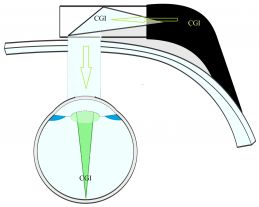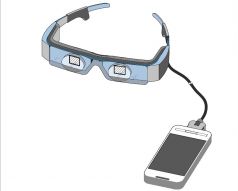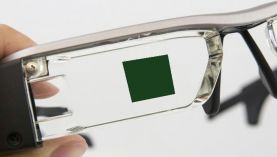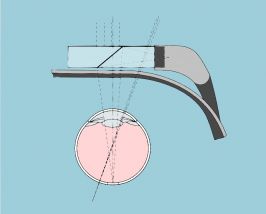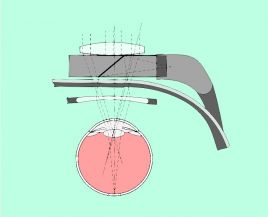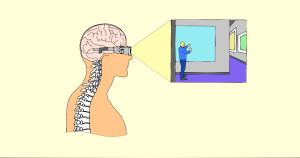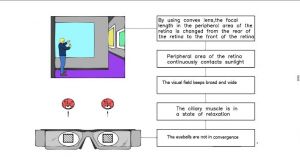AR Computers To Terminate Eyestrain And Myopia
All content on Eyewiki is protected by copyright law and the Terms of Service. This content may not be reproduced, copied, or put into any artificial intelligence program, including large language and generative AI models, without permission from the Academy.
Introduction
In humans, prolonged contraction of the ciliary and medial rectus muscles during close reading will result in eye strain.
On the other hand, eye strain will not occur if the ciliary and medial rectus muscles do not contract during close reading.
About 2cm in front of the eye, the Near-Eye Display (NED)[1] technology of Augmented Reality smart glasses (AR glasses) projects computer generated images/informations(CGIs) directly onto the retina, and this provides a passive way for our eyes to acquire information.
Factors contributing to eyestrain and myopia
In the medical community, the main factors considered to causing eye fatigue and myopia are as follows:
1. Long-term contraction of the ciliary muscle.
2. Long-term contraction of the medial rectus muscle.
3. Insufficient exposure of the retina to sunlight.[2]
4. The eye not exhibiting peripheral myopia.[3]
5. Peripheral visual field deprivation.[4]
Disease prevention
"Evidence is mounting that myopia is growing around the world, with a recent study estimating that on average, 30% of the world is currently myopic and by 2050, almost 50% will be myopic, that’s a staggering 5 billion people."
https://myopiainstitute.org/myopia/
Augmented reality smart glasses have the potential to play an important role in the prevention of asthenopia and myopia.
Termination of asthenopia
When using AR glasses, its translucent display allows your eyes to receive two light sources at the same time, one is ambient light from the real world, and the other is projected by the NED.
When the display becomes opaque, light from the real world will not penetrate, and your eye will only receive the light from the NED.
Similar in principle to an ophthalmoscope shining light into the eye, the NED of AR glasses actively projects CGI onto the retina.
①. Once any refractive errors are corrected, people of any age can receive the CGI clearly via the retina; this indicates that the light projected from the NED is indeed parallel light.
②. Once the refractive error is corrected, the CGI projected through the parallel light is naturally focused on the etina(=macula) without any accommodation.
③. By extension of the accommodation-vergence reflex, no convergence.
Therefore, there is no contraction of the ciliary and medial rectus muscle.
So by using a modified augmented reality glasses, humans can read at close range with both the ciliary and medial rectus muscles relaxed, and the eyes will never get tired.
Prevention of myopia
AR glasses can be turned into AR computers by appending a piece of opaque material on the front of the screen to turn the see-through display into a non see-through one and installing the software required in its host.
Thus, an AR computer can be called an ophthalmoscope with a computer host.
• The AR computer is equipped with a light-transmittable part around the opaque display. The opaque display allows the user to face the sun and use sunlight as the background light source. The opaque display protects the eyeball and the macula, while the light-transmittable part allows the peripheral retina to come into contact with sunlight.
• The AR computer can be equipped with convex lenses around the opaque display. The convex lens can shorten the focal length of the light around the opaque display (i.e. the macula area) and change the light that is originally focused on the outside of the retina to the inside, turning the relative peripheral hyperopia into peripheral myopia.
• With the head raised, the light-transmittable part of an AR computer provides a wide field of view, eliminating the phenomenon where the peripheral visual field is deprived when reading with the head down.
Thus, the AR computer can simultaneously overcome all the major factors contributing to myopia.
Further advantages
The AR computer can complete all tasks a traditional PC is capable of, such as editing documents, browsing the web, emails, media playing etc. It also has the unique ability of AR glasses.
No reading glasses required
As long as the refractive error is corrected, the parallel light will naturally focus on the retina, people of any age can get a clear picture, so the elderly do not need reading glasses when using AR computers.
No dizziness
As both the ciliary and medial rectus muscles are relaxed, there is no vergence-accommodation conflict (VAC), so there is neither dizziness nor VR motion sickness experienced by the user.
No back pain
You can take a supine position while using the AR computer. Being able to lie down means you can relax most of the muscles in your body and the intervertebral discs won't be compressed, so you won't have lower back pain.
No neck stiffness
The virtual image moves with the line of sight, so users can move their head and neck freely without having to keep looking down. Therefore, the shoulder and neck will not be stiff.
No vertebrae overlap
When using the AR computer lying down, the spine can be stretched out, the vertebrae no longer overlap each other, and the intervertebral discs are not compressed.
Less physical fatigue
Being able to lie down and use the AR computer means that most of the muscles in your body, including the ciliary and medial rectus muscles, are in a relaxed state, so your body will no longer suffer from soreness and fatigue and also save more energy than any other working position.
Dynamic reading instead of static reading
The light-transmitting part allows users to see the surrounding environment when using the AR computer, so you can change your posture and move your body at any time. Therefore, it encourages dynamic reading rather than static reading to avoid complications of a sedentary lifestyle. Users can even move around within the confines of a secure environment.
No need to turn on the lights
When we are using AR computers during the day, as long as we are facing a sunny place, we don’t need to turn on the lights.
No glare
The non see-through display blocks out light sources from the real world, and the retina only receives parallel light from the NED technology. So generally speaking there is no glare.
No isolation
The light-transmittable part of the AR computer allows users to contact the surroundings, avoiding isolation from the environment and other users.
No physical screen needed
When CGI is projected onto the retina, a virtual screen will appear in front of you and move freely with your line of sight. You can put it on the wall, on the ceiling, in mid-air, whereever you like.
Dual-display
A binocular AR computer is equipped with two screens. Instead of sharing a screen, each eye has its own screen.
Relieve eye fatigue
Once the refractive error is corrected, both the ciliary and medial rectus muscles are relaxed. Therefore, the use of AR computer may relieve eye fatigue caused by prolonged contraction of the ciliary and medial rectus muscles due to long-term close reading.
Unaffected by vehicle vibration
The display of the AR Computer moves synchronously with the user’s eyes, and the images remain clear and stable even on moving vehicles.
Sunlight instead of artificial light
The opaque display of the AR computer protects the eyeball and the macula, allowing the user to face the sun with sunlight as the background light source.
Outdoors
The opaque display of the AR computer protects the eyeball and the macula, keeps the clarify and contrast of the CGI and encourages users to go outdoors,e.g. in the woods, by the river, etc.
Environmentally friendly
When AR Computer users go outdoors or face the outside, the use of artificial light is reduced, saving energy and being environmentally friendly.
Conclusion
Eye fatigue and myopia have endangered human beings for thousands of years, and despite various treatments, the myopic population continues to rise.
The NED technology provides a passive way for our eyes to receive informations which is completely different from the way humans have been using their eyes to actively find objects and read information since ancient time. This has revolutionized the mechanism for reading at close range, and is undoubtedly worthy of further exploration.
Although its results still need to be supported by clinical trial data, the fact that AR computer overcomes the currently known factors of myopia is promising.
References
- ↑ http://www.kessleroptics.com/portfolio/near-to-eye-displays
- ↑ Erica G. Landis, Victoria Yang, Dillon M. Brown, Machelle T. Pardue, Scott A. Read; Dim Light Exposure and Myopia in Children. Invest. Ophthalmol. Vis. Sci. 2018;59(12):4804-4811. doi: https://doi.org/10.1167/iovs.18-24415.
- ↑ Alexandra Benavente-Pérez, Ann Nour, David Troilo; Axial Eye Growth and Refractive Error Development Can Be Modified by Exposing the Peripheral Retina to Relative Myopic or Hyperopic Defocus. Invest. Ophthalmol. Vis. Sci. 2014;55(10):6765-6773. doi: https://doi.org/10.1167/iovs.14-14524.
- ↑ Smith EL 3rd, Hung LF, Arumugam B. Visual regulation of refractive development: insights from animal studies. Eye (Lond). 2014 Feb;28(2):180-8. doi: 10.1038/eye.2013.277. Epub 2013 Dec 13. PMID: 24336296; PMCID: PMC3930279.


